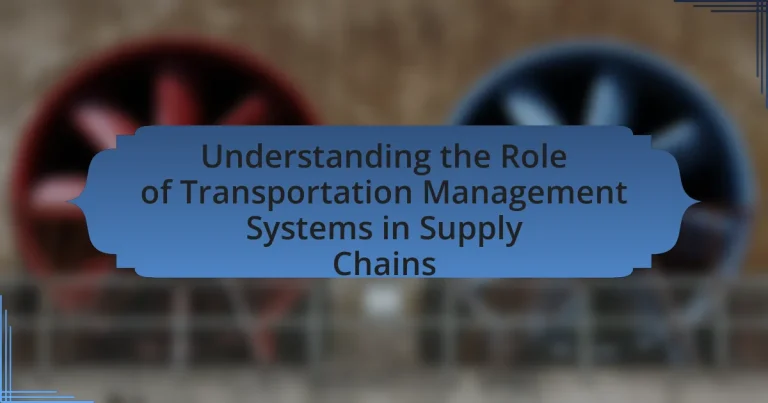A Transportation Management System (TMS) is a software platform essential for optimizing the planning, execution, and monitoring of goods movement within supply chains. This article explores the functionalities of TMS, including route optimization, load planning, and real-time tracking, which collectively enhance operational efficiency and reduce transportation costs by 10-15%. It also examines the integration of TMS with other supply chain technologies, the critical role of real-time data, and the specific advantages it offers to various industries such as retail and manufacturing. Additionally, the article outlines best practices for successful TMS implementation, including the importance of training and continuous improvement strategies to maximize system effectiveness.
What is a Transportation Management System (TMS) in Supply Chains?
A Transportation Management System (TMS) in supply chains is a software platform designed to facilitate the planning, execution, and optimization of the physical movement of goods. TMS enables organizations to manage transportation operations efficiently by providing tools for route planning, carrier selection, freight auditing, and shipment tracking. According to a report by Gartner, companies that implement TMS can reduce transportation costs by 10-15% and improve service levels, demonstrating the system’s effectiveness in enhancing supply chain performance.
How does a TMS function within supply chain operations?
A Transportation Management System (TMS) functions within supply chain operations by optimizing the planning, execution, and monitoring of the transportation of goods. It enables companies to manage their logistics more efficiently by automating processes such as route planning, carrier selection, and freight auditing. For instance, a TMS can analyze various shipping options to determine the most cost-effective and timely routes, thereby reducing transportation costs and improving delivery performance. Additionally, it provides real-time visibility into shipment status, allowing for better decision-making and enhanced customer service. According to a study by Gartner, organizations that implement a TMS can achieve a 10-15% reduction in transportation costs and a significant improvement in service levels.
What are the key features of a Transportation Management System?
A Transportation Management System (TMS) primarily features route optimization, load planning, freight auditing, and real-time tracking. Route optimization enables efficient planning of delivery paths, reducing transportation costs and time. Load planning maximizes cargo space utilization, ensuring that shipments are cost-effective. Freight auditing automates the verification of freight bills, identifying discrepancies and ensuring accurate billing. Real-time tracking provides visibility into shipment status, enhancing customer service and operational efficiency. These features collectively improve supply chain performance by streamlining logistics processes and reducing operational costs.
How does a TMS integrate with other supply chain technologies?
A Transportation Management System (TMS) integrates with other supply chain technologies through application programming interfaces (APIs) and data exchange protocols. This integration allows for seamless communication between the TMS and systems such as Enterprise Resource Planning (ERP), Warehouse Management Systems (WMS), and Customer Relationship Management (CRM) platforms. For example, a TMS can pull order data from an ERP system to optimize shipping routes and costs, while also sending shipment status updates back to the ERP for real-time inventory management. This interconnectedness enhances visibility, improves decision-making, and streamlines operations across the supply chain.
What are the primary objectives of implementing a TMS?
The primary objectives of implementing a Transportation Management System (TMS) include optimizing transportation operations, reducing costs, improving service levels, and enhancing visibility across the supply chain. A TMS achieves operational optimization by automating route planning and carrier selection, which leads to more efficient use of resources. Cost reduction is facilitated through better freight management and negotiation capabilities, allowing companies to secure more favorable shipping rates. Improved service levels are realized by providing accurate delivery estimates and tracking shipments in real-time, which enhances customer satisfaction. Lastly, enhanced visibility is achieved through centralized data management, enabling stakeholders to monitor performance metrics and make informed decisions.
How does a TMS improve efficiency in transportation management?
A Transportation Management System (TMS) improves efficiency in transportation management by automating and optimizing logistics processes. By providing real-time data and analytics, a TMS enables better route planning, load optimization, and carrier selection, which reduces transportation costs and delivery times. For instance, studies show that companies using TMS can achieve up to a 10-15% reduction in freight costs and a 20-30% improvement in on-time deliveries. This efficiency is further enhanced through features like shipment tracking and performance monitoring, allowing for proactive decision-making and continuous improvement in supply chain operations.
What cost-saving opportunities does a TMS provide?
A Transportation Management System (TMS) provides several cost-saving opportunities, primarily through optimized routing and load planning. By analyzing various transportation routes and consolidating shipments, a TMS can reduce fuel costs and improve delivery efficiency. For instance, studies show that companies using TMS solutions can achieve up to a 10-15% reduction in transportation costs by minimizing empty miles and maximizing load capacity. Additionally, a TMS enhances visibility and tracking, allowing for better management of freight costs and reducing the likelihood of delays, which can incur additional expenses.
Why is a TMS critical for modern supply chains?
A Transportation Management System (TMS) is critical for modern supply chains because it enhances efficiency, reduces costs, and improves visibility throughout the logistics process. By automating key functions such as route optimization, load planning, and carrier selection, a TMS enables companies to streamline operations and make data-driven decisions. For instance, research indicates that organizations using TMS can achieve up to a 10% reduction in transportation costs and a 15% improvement in delivery performance. This efficiency not only leads to cost savings but also enhances customer satisfaction by ensuring timely deliveries and better tracking capabilities.
How does a TMS enhance visibility and tracking in logistics?
A Transportation Management System (TMS) enhances visibility and tracking in logistics by providing real-time data on shipment status and location. This system integrates various data sources, allowing logistics managers to monitor shipments throughout the entire supply chain. For instance, a TMS can utilize GPS tracking and RFID technology to provide accurate updates on delivery times and potential delays, thereby improving decision-making and operational efficiency. According to a study by the Council of Supply Chain Management Professionals, companies that implement a TMS report a 10-15% increase in visibility, which directly correlates with improved customer satisfaction and reduced operational costs.
What role does real-time data play in transportation management?
Real-time data is crucial in transportation management as it enhances decision-making and operational efficiency. By providing up-to-the-minute information on vehicle locations, traffic conditions, and delivery statuses, real-time data enables transportation managers to optimize routes, reduce delays, and improve customer service. For instance, a study by the American Transportation Research Institute found that real-time traffic data can reduce travel times by up to 20%, demonstrating its significant impact on logistics efficiency. Additionally, real-time data facilitates proactive responses to disruptions, allowing for immediate adjustments in transportation plans, which ultimately leads to cost savings and improved supply chain performance.
How does improved visibility impact decision-making in supply chains?
Improved visibility significantly enhances decision-making in supply chains by providing real-time data and insights into inventory levels, shipment statuses, and demand fluctuations. This access to timely information allows supply chain managers to make informed decisions, optimize inventory management, and reduce lead times. For instance, a study by the Council of Supply Chain Management Professionals found that companies with high visibility in their supply chains experience a 15% reduction in inventory costs and a 20% improvement in order fulfillment rates. This data-driven approach enables proactive responses to disruptions and better alignment of supply with customer demand, ultimately leading to increased efficiency and customer satisfaction.
What challenges does a TMS help to overcome?
A Transportation Management System (TMS) helps to overcome challenges such as inefficient routing, high transportation costs, and lack of visibility in supply chain operations. By optimizing routes, a TMS reduces fuel consumption and delivery times, which directly lowers costs. Additionally, it provides real-time tracking and data analytics, enhancing visibility and enabling better decision-making. According to a study by the Council of Supply Chain Management Professionals, companies using TMS solutions can achieve up to a 10% reduction in transportation costs and a 15% improvement in delivery performance, validating the effectiveness of TMS in addressing these challenges.
How does a TMS address issues related to route optimization?
A Transportation Management System (TMS) addresses issues related to route optimization by utilizing advanced algorithms and real-time data analytics to determine the most efficient routes for transportation. These systems analyze various factors such as traffic patterns, delivery windows, vehicle capacity, and fuel costs to create optimized routing plans. For instance, a study by the University of Michigan found that TMS solutions can reduce transportation costs by up to 10-15% through effective route planning. By continuously updating routes based on real-time conditions, a TMS enhances delivery efficiency and reduces delays, ultimately improving overall supply chain performance.
What are the implications of poor transportation management on supply chains?
Poor transportation management significantly disrupts supply chains by causing delays, increasing costs, and reducing service quality. Delays in transportation lead to missed delivery deadlines, which can result in stockouts and lost sales opportunities. Increased costs arise from inefficient routing, higher fuel consumption, and potential penalties for late deliveries. Additionally, poor management can diminish customer satisfaction due to unreliable service, ultimately harming a company’s reputation and competitive edge. According to a study by the Council of Supply Chain Management Professionals, companies that optimize their transportation management can reduce logistics costs by up to 10%, highlighting the critical importance of effective transportation management in maintaining efficient supply chains.
What are the different types of Transportation Management Systems?
The different types of Transportation Management Systems (TMS) include On-Premise TMS, Cloud-Based TMS, and SaaS (Software as a Service) TMS. On-Premise TMS is installed locally on a company’s servers and offers full control over the system, while Cloud-Based TMS is hosted on the vendor’s servers, providing flexibility and scalability. SaaS TMS operates on a subscription model, allowing companies to access the software via the internet without the need for extensive IT infrastructure. Each type serves distinct operational needs and can enhance efficiency in supply chain management by optimizing transportation processes.
How do cloud-based TMS solutions differ from on-premise systems?
Cloud-based Transportation Management Systems (TMS) differ from on-premise systems primarily in their deployment and accessibility. Cloud-based TMS solutions are hosted on remote servers and accessed via the internet, allowing for real-time updates and collaboration from any location, while on-premise systems require installation on local servers and are limited to specific physical locations. This difference in deployment leads to variations in cost structure; cloud-based solutions typically operate on a subscription model, reducing upfront capital expenditures, whereas on-premise systems involve significant initial investment in hardware and software. Additionally, cloud-based TMS solutions often provide automatic updates and scalability, enabling businesses to adapt quickly to changing needs, while on-premise systems may require manual updates and can be less flexible in accommodating growth.
What are the advantages of using a cloud-based TMS?
The advantages of using a cloud-based Transportation Management System (TMS) include enhanced accessibility, scalability, and cost-effectiveness. Cloud-based TMS solutions allow users to access the system from anywhere with an internet connection, facilitating real-time collaboration and decision-making. Additionally, these systems can easily scale to accommodate business growth or seasonal fluctuations, ensuring that companies only pay for the resources they need. According to a report by Gartner, organizations that adopt cloud-based solutions can reduce IT costs by up to 30%, demonstrating the financial benefits of this technology.
In what scenarios would an on-premise TMS be more beneficial?
An on-premise Transportation Management System (TMS) is more beneficial in scenarios where data security and compliance are critical. Organizations that handle sensitive information, such as financial data or personally identifiable information, often prefer on-premise solutions to maintain control over their data and ensure compliance with regulations like GDPR or HIPAA. Additionally, companies with complex logistics operations that require extensive customization may find on-premise TMS more advantageous, as these systems can be tailored to specific business needs without the limitations often found in cloud-based solutions. Furthermore, businesses operating in regions with unreliable internet connectivity may benefit from on-premise systems, as they do not rely on constant internet access for functionality.
What industries benefit most from using a TMS?
The industries that benefit most from using a Transportation Management System (TMS) include retail, manufacturing, logistics, and e-commerce. These sectors rely heavily on efficient transportation and logistics to manage supply chains effectively. For instance, the retail industry utilizes TMS to optimize delivery routes, reduce shipping costs, and improve customer satisfaction through timely deliveries. In manufacturing, TMS aids in coordinating inbound and outbound shipments, ensuring that materials arrive just in time for production. Logistics companies leverage TMS for real-time tracking and management of freight, enhancing operational efficiency. E-commerce businesses benefit from TMS by streamlining order fulfillment processes and managing high volumes of shipments, particularly during peak seasons.
How does a TMS cater to the needs of the retail industry?
A Transportation Management System (TMS) caters to the needs of the retail industry by optimizing logistics operations, enhancing supply chain visibility, and improving cost efficiency. Retailers utilize TMS to streamline the planning, execution, and tracking of shipments, which is crucial for managing inventory levels and meeting customer demand. For instance, a study by Gartner indicates that companies using TMS can reduce transportation costs by 10-15% and improve delivery performance by 20-30%. This efficiency is vital in the retail sector, where timely delivery and cost control directly impact profitability and customer satisfaction.
What specific advantages does a TMS offer to the manufacturing sector?
A Transportation Management System (TMS) offers several specific advantages to the manufacturing sector, including improved efficiency, cost reduction, enhanced visibility, and better compliance. Improved efficiency is achieved through automated processes that streamline logistics operations, reducing manual errors and saving time. Cost reduction occurs as a TMS optimizes shipping routes and consolidates shipments, leading to lower transportation expenses. Enhanced visibility allows manufacturers to track shipments in real-time, facilitating proactive decision-making and better inventory management. Additionally, a TMS helps ensure compliance with regulations by maintaining accurate records and facilitating reporting, which is crucial in the highly regulated manufacturing environment. These advantages collectively contribute to a more agile and responsive supply chain.
How can organizations effectively implement a TMS?
Organizations can effectively implement a Transportation Management System (TMS) by following a structured approach that includes assessing needs, selecting the right software, and ensuring proper training. First, organizations should conduct a thorough analysis of their logistics requirements to identify specific functionalities needed in a TMS, such as route optimization and freight auditing. Next, selecting a TMS that aligns with these needs is crucial; for instance, a study by Gartner highlights that 70% of organizations that choose a TMS based on their unique requirements see improved efficiency. Finally, providing comprehensive training for staff ensures that the system is utilized to its full potential, as research from the Council of Supply Chain Management Professionals indicates that effective training can lead to a 30% increase in system adoption rates.
What steps should be taken to ensure successful TMS adoption?
To ensure successful Transportation Management System (TMS) adoption, organizations should follow a structured approach that includes stakeholder engagement, thorough training, and continuous evaluation. Engaging stakeholders from various departments fosters buy-in and ensures that the system meets diverse needs. Comprehensive training programs equip users with the necessary skills to utilize the TMS effectively, which is crucial for maximizing its benefits. Continuous evaluation through performance metrics and user feedback allows organizations to identify areas for improvement and adapt the system to changing requirements. These steps are supported by industry research indicating that organizations with strong stakeholder involvement and training programs experience higher TMS adoption rates and improved operational efficiency.
How important is training for staff in the implementation process?
Training for staff is crucial in the implementation process of Transportation Management Systems (TMS) in supply chains. Effective training ensures that employees understand the functionalities and benefits of the TMS, which directly impacts operational efficiency and user adoption rates. Research indicates that organizations that invest in comprehensive training programs experience a 30% increase in system utilization and a 20% reduction in implementation time, demonstrating the tangible benefits of well-trained staff in maximizing the potential of TMS.
What common pitfalls should organizations avoid during TMS implementation?
Organizations should avoid inadequate planning during TMS implementation. Insufficient assessment of current processes and failure to define clear objectives can lead to misalignment between the TMS capabilities and organizational needs. Additionally, neglecting user training can result in low adoption rates and ineffective use of the system. Research indicates that 70% of TMS implementations fail due to lack of user engagement and support. Furthermore, overlooking data integration challenges can hinder the system’s effectiveness, as seamless data flow is crucial for optimizing transportation operations.
What best practices can enhance the effectiveness of a TMS?
Implementing best practices such as data integration, real-time tracking, and continuous optimization can significantly enhance the effectiveness of a Transportation Management System (TMS). Data integration allows for seamless communication between various supply chain components, ensuring that all stakeholders have access to accurate and timely information. Real-time tracking improves visibility and accountability, enabling proactive decision-making and reducing delays. Continuous optimization involves regularly analyzing performance metrics and adjusting strategies to improve efficiency and reduce costs. According to a study by Gartner, organizations that effectively utilize TMS can achieve up to a 15% reduction in transportation costs and a 20% improvement in service levels, demonstrating the tangible benefits of these best practices.
How can continuous improvement strategies be applied to TMS usage?
Continuous improvement strategies can be applied to Transportation Management System (TMS) usage by implementing regular performance assessments and feedback loops. These strategies involve analyzing key performance indicators (KPIs) such as delivery times, transportation costs, and customer satisfaction to identify areas for enhancement. For instance, a study by the Council of Supply Chain Management Professionals found that companies utilizing TMS effectively reduced transportation costs by 10-15% through ongoing optimization efforts. By fostering a culture of continuous improvement, organizations can adapt their TMS functionalities to evolving supply chain demands, ensuring sustained efficiency and effectiveness.
What metrics should organizations track to measure TMS success?
Organizations should track key performance indicators (KPIs) such as cost per shipment, on-time delivery rate, and freight spend as metrics to measure Transportation Management System (TMS) success. Cost per shipment provides insight into the efficiency of transportation spending, while on-time delivery rate reflects the reliability of the logistics process. Freight spend allows organizations to assess overall transportation costs against budgeted amounts. According to a study by the Council of Supply Chain Management Professionals, companies that effectively measure these metrics can achieve up to a 15% reduction in transportation costs and a 20% improvement in delivery performance.



